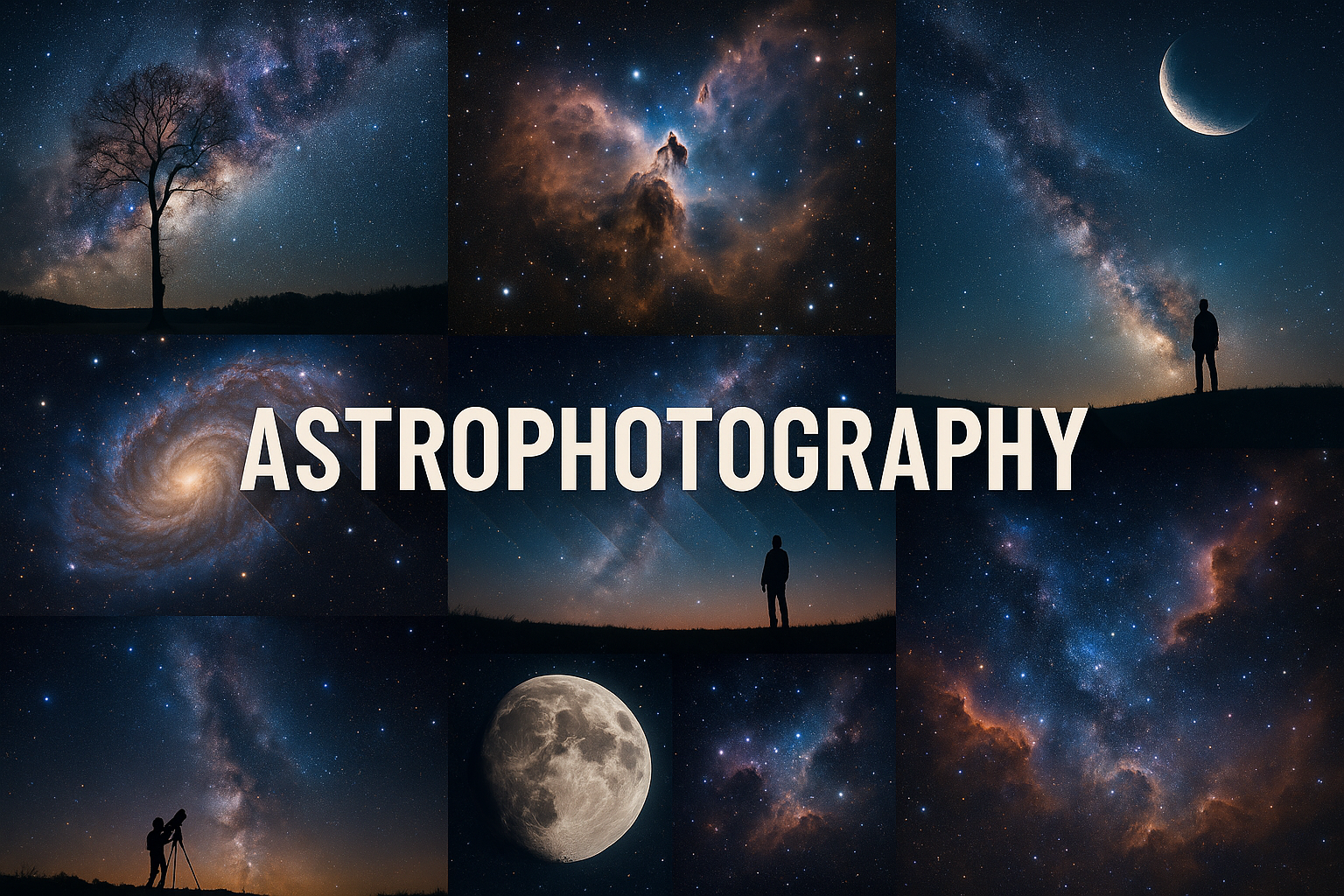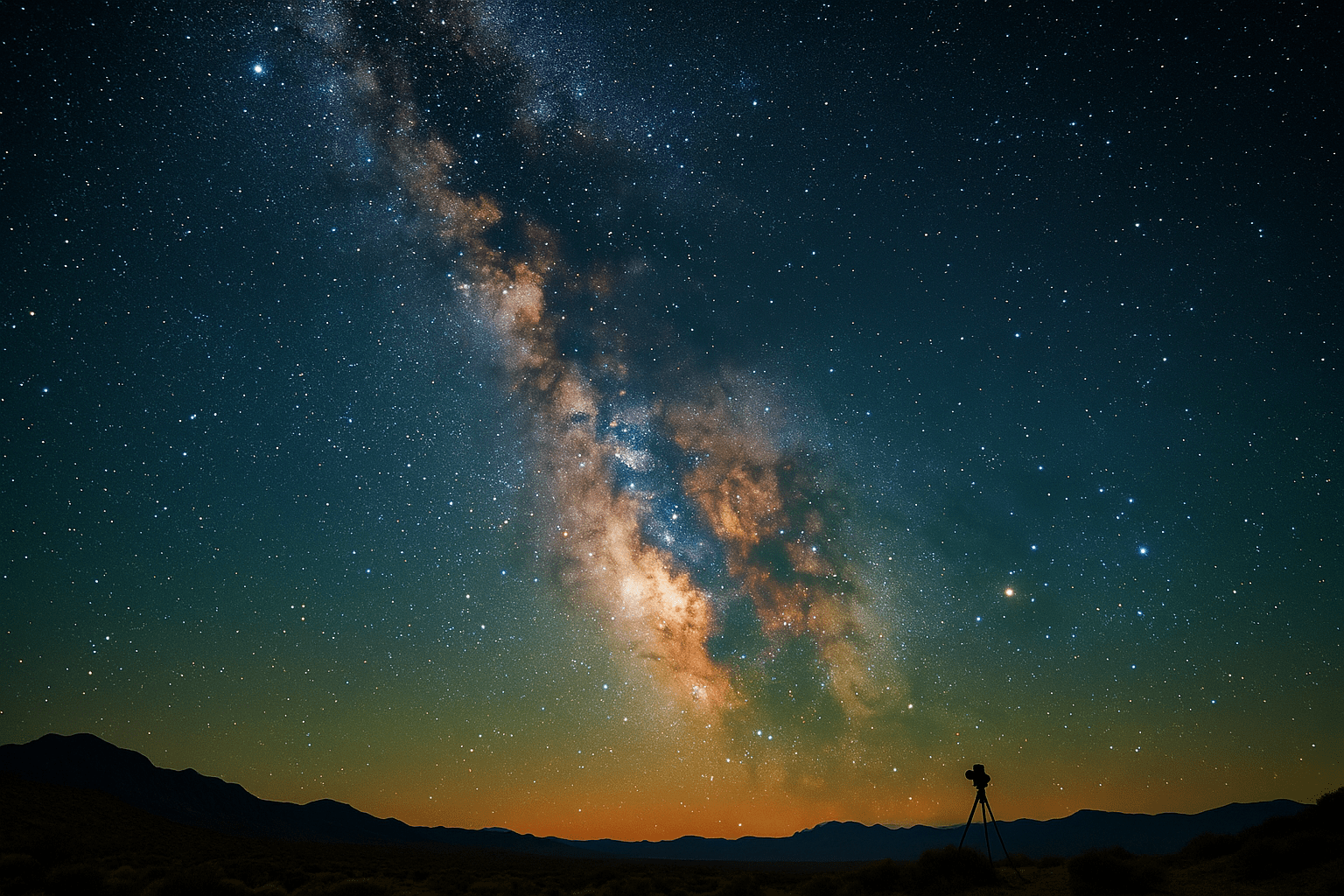
Astrophotography
Astrophotography is a type of photography that focuses on capturing images of astronomical objects and phenomena. These images can be of stars, planets, nebulae, galaxies, and other celestial bodies. Astrophotography often requires specialized equipment, such as telescopes and cameras that are designed for capturing images in low-light conditions.
AOI thinking about Astrophotography [+_~]-/
Overview and Quickfacts
Astrophotography is a type of photography that focuses on capturing images of astronomical objects, sites, and events. This type of photography often requires special equipment and techniques, as well as a knowledge of astronomy.
Can understand it also, as:
Space photography, astronomical photography, night sky photography
Categorize it as:
Impressionism, Modernism
.: Dreaming :.
holds a HAIKU for the art style
:. Thought is power .:
Detailed Description
Astrophotography is a genre of photography that involves capturing images of astronomical objects and phenomena. These images can be of stars, planets, nebulae, galaxies, and other astronomical objects. Astrophotography can be done with a DSLR camera, a telescope, or a specialized astrophotography camera. Some of the most famous astrophotographers include Robert Gendler, David Malin, and Jay Pasachoff. Robert Gendler is known for his images of galaxies, nebulae, and star clusters. David Malin is known for his images of galaxies and nebulae. Jay Pasachoff is known for his images of the Sun, planets, and stars. There are many different types of astrophotography, including wide-field, deep-sky, solar, and planetary. Wide-field astrophotography involves capturing images of large areas of the sky. Deep-sky astrophotography involves capturing images of specific astronomical objects, such as galaxies and nebulae. Solar astrophotography involves capturing images of the Sun. Planetary astrophotography involves capturing images of planets and their moons. Astrophotography can be a challenging genre of photography, but the results can be stunning. If you’re interested in trying astrophotography, be sure to do your research and practice beforehand. With the right equipment and preparation, you can capture some amazing images of the night sky.
.. beep, beep, beep ..
<START OF TRANSMISSION>
1. Astrophotography is the art and science of photographing celestial objects. 2. The first recorded attempt at astrophotography was made in 1840 by William Henry Fox Talbot. 3. Talbot's photograph of the Moon was the first ever published photograph of a celestial object. 4. In the early days of astrophotography, long exposure times were required to capture images of faint objects. 5. The first photograph of a star was taken in 1850 by John William Draper. 6. In the late 19th century, astrophotography became more widely accessible with the development of dry plates and faster lenses. 7. The first photograph of a nebula was taken in 1883 by Isaac Roberts. 8. In the early 20th century, astrophotography was used to map the positions of stars and planets. 9. In the mid-20th century, astrophotography became increasingly popular with amateur astronomers. 10. Modern astrophotography often uses digital cameras and computer-controlled telescopes. 11. Astrophotography can be used to capture images of the Sun, Moon, planets, stars, nebulae, and galaxies. 12. The exposure times required for astrophotography vary depending on the brightness of the object being photographed. 13. Dark-sky locations are often preferred for astrophotography to minimize light pollution. 14. A variety of specialized equipment is often used for astrophotography, such as tracking mounts and filters. 15. Post-processing of astrophotographs is often required to bring out the detail in the images. 16. Astrophotography can be challenging, but the results can be stunning and rewarding. 17. There are many online resources available to help with astrophotography, including forums, tutorials, and software. 18. There are also many astrophotography clubs and groups around the world that can offer support and advice. 19. Astrophotography can be a lifelong passion, with new challenges and rewards at every turn. 20. There's no better way to explore the universe than through the lens of a camera.
<EOF>
.. robbel bob
Visual Examples from our image gallery
Coming soon, we are so slow .. might never come
Artists, Paintings, and more
(be aware, can be highly speculative)
Artists (be aware, speculation possible):
1. William Henry Fox Talbot (1800-1877) 2. John William Draper (1811-1882) 3. Lewis Morris Rutherfurd (1816-1892) 4. Julia Margaret Cameron (1815-1879) 5. Henry Draper (1837-1882) 6. Edward Emerson Barnard (1857-1923) 7. Isaac Roberts (1829-1904) 8. David Gill (1843-1914) 9. Williamina Fleming (1857-1911) 10. Annie Jump Cannon (1863-1941) 11. Edward Charles Pickering (1846-1919) 12. Henry Norris Russell (1877-1957) 13. Vesto Melvin Slipher (1875-1969) 14. Carl Otto Lampland (1873-1928) 15. Heber Curtis (1872-1942) 16. Harlow Shapley (1885-1972) 17. Edwin Hubble (1889-1953) 18. Fritz Zwicky (1898-1974) 19. Walter Baade (1893-1960) 20. Nicholas U. Mayall (1906-1993) 21. Margaret Burbidge (1919-2020) 22. Edwin Powell Hubble (1889-1953) 23. Allan Sandage (1926-2010) 24. Maarten Schmidt (1929-2010) 25. Arno Penzias (1933-2020) 26. Robert Woodrow Wilson (1936-2020) 27. James Peebles (1935-2020) 28. Vera Rubin (1928-2016) 29. Sandra Faber (1945-2019) 30. Geoffrey Marcy (1954-
Artworks (be aware, speculation possible)
1. The Great Wave off Kanagawa, Katsushika Hokusai (1829-1833) 2. The Starry Night, Vincent van Gogh (1889) 3. The Hay Wagon, Andrew Wyeth (1945) 4. The Milky Way, Salvador Dali (1949) 5. The Andromeda Galaxy, Edwin Hubble (1952) 6. The Sun, A. E. Douglass (1953) 7. The Horsehead Nebula, Robert Gendler (1984) 8. The Pillars of Creation, Hubble Space Telescope (1995) 9. The Sombrero Galaxy, Hubble Space Telescope (2003) 10. The Eagle Nebula, Hubble Space Telescope (2005) 11. The Carina Nebula, Hubble Space Telescope (2010) 12. The Crab Nebula, Hubble Space Telescope (2010) 13. The Tarantula Nebula, Hubble Space Telescope (2010) 14. The Lagoon Nebula, Hubble Space Telescope (2010) 15. The Orion Nebula, Hubble Space Telescope (2010) 16. The Helix Nebula, Hubble Space Telescope (2010) 17. The Flame Nebula, Hubble Space Telescope (2010) 18. The Rosette Nebula, Hubble Space Telescope (2010) 19. The Trifid Nebula, Hubble Space Telescope (2010) 20. The Pleiades, Hubble Space Telescope (2010) 21. The Crab Pulsar, Hubble Space Telescope (2010) 22. The Vela Pulsar, Hubble Space Telescope (2010) 23. The Cone Nebula, Hubble Space Telescope (2010) 24. The Christmas Tree Cluster, Hubble Space Telescope (2010) 25. The Jewel Box Cluster, Hubble Space Telescope (2010) 26. The Omega Nebula, Hubble Space Telescope (2010) 27. The Eagle Nebula’s Pillars of Creation, Hubble Space Telescope (2015) 28. The Cat’s Eye Nebula, Hubble Space Telescope (2015) 29. The Antennae Galaxies, Hubble Space Telescope (2015) 30. The Whirlpool Galaxy, Hubble Space Telescope (2015)
Epoch
The art style of astrophotography emerged in the late 19th century.
AI ART RESSOURCES (AKA, well Tools)
Helping tools -> predefined search links on other pages:











